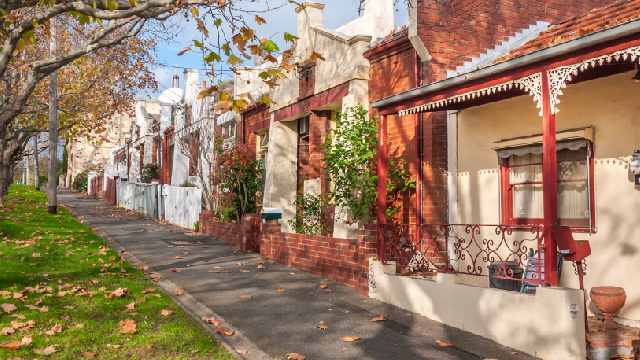Is this the beginning of the end of our property boom?

Property prices have had a great run but how long can this go on? Property expert, Michael Yardney, weighs in.
Australian property prices rose 1.5% in the month of September, according to data by CoreLogic. This is despite the fact that many of us were still living in a COVID-19 cocoon.
Housing values surged 20.3% higher in the past year, pumped up by reassurances of the Reserve Bank of Australia (RBA) that the cash rate will stay at the current record low level until at least 2024.
This has many people asking: “How long can this go on? What’s going to end this property cycle?”
Well, the market is already slowing down. It has become increasingly clear our housing market has moved past its peak rate of growth which occurred in March when national dwelling values increased by 2.8%.
The slowing growth conditions are the result of affordability issues as property values have grown significantly at a time when wages growth has languished along with fewer government incentives to enter the market.
Having said that, it looks like October could be a stronger month as confidence is increasing as the end of lockdowns are in sight.
In other words, we’re still getting annualised double-digit growth, and this has added $1 trillion to Aussie household wealth in the first half of the year.
So how long will this go on?
If you would have asked me this question a couple of weeks ago I would have suggested that our property market would continue growing at the rate of 6% to 7% per annum throughout 2022 until eventually, affordability slowed the market down.
Remember, the current upturn phase of the property cycle only commenced a year ago, in October 2020.
Normally, the upturn stage of the property cycle lasts a number of years and is followed by a shorter boom phase which is eventually cut short by the RBA raising interest rates or by APRA introducing macroprudential controls to dampen the exuberance of property investors and home buyers.
However, this time around we have experienced an unprecedented rate of growth seeing our property markets perform even more strongly than anyone ever expected, with the rates of house price growth at levels not seen for a number of decades.
While a lot has been said about the 20% increase in property values many locations have enjoyed so far this year, it must be remembered that the last peak for our property markets was in 2017, and in many locations, housing prices remained stagnant over the subsequent couple of years and it was really only earlier this year that new highs were reached.
This means that average price growth was unexceptional over the long term, averaging out at around 4% per annum over the past five years.

Lending rules tightened
But over the past couple of weeks, there has been a sudden change of sentiment about our housing markets from our financial regulators, the banks and even our treasurer.
Recently the Council of Financial Regulators, the club of four main financial watchdogs, showed concern about the increased level of home lending in the first half of the year.
In particular, they signalled their concern about the number of mortgages taken out at more than six times the borrower’s income.
The council asked APRA to put together a list of potential measures. Within a couple of days APRA responded and instructed banks and other authorised lenders that from November borrowers will need to be able to meet repayments at least 3% higher than the loan product rate to receive a loan rather than 2.5%.
If, for example, you apply for a mortgage with an interest rate of 2.5%, the bank must now assess that you will still be able to make repayments if the rate rises to 5.5% – rather than the previous serviceability assumption of 5%.
These changes mean the maximum borrowing capacity for the average borrower will reduce by around 5%.
Interestingly the new 3% buffer rate does not apply to non-bank lenders. However, APRA is considering including them later this year.
→ Related: APRA tightens home loan lending rules, as Aussies take on more debt
While tougher lending standards will certainly take some heat out of Australia’s property markets by restricting the number of people that can get home loans, or lessen the amount they can borrow, it seems like the regulators are aiming to gently apply the brakes to the housing market, rather than slam them on.
There could be more macroprudential controls to come.
This increase in the serviceability buffer comes ahead of a broader information paper, due in the next couple of months, that will outline APRA’s approach to macroprudential policy in more detail.
Further measures, specifically debt to income limits are a possibility with APRA signalling this by requesting lenders “review their risk appetites for lending at high debt-to-income ratios” and that further macroprudential measures would be considered if concentrations of high debt-to-income loans continue to rise (currently around 22% of new loans have a debt-to-income ratio greater than 6x).
When will the property boom end?
So, back to the question of when will this property cycle end?
There is little doubt that these macroprudential controls will have a negative impact on our property markets and slow the rate of growth of housing values. After all, that’s what they’re intended to do.
Whether the markets will just experience slower growth or stop dead in their tracks will depend on what other measures are introduced.
The recently introduced measures are just going to slow the market down from sixth gear into third or fourth gear – our property markets are not going into reverse.
It is likely that targeting debt-to-income ratios will have a limited impact on higher wealth households, who often have multiple streams of income.
However, it will affect lower-income households and those purchasing property for the first time. If you think about it, first home buyers don’t have a ‘trade in’ of a previous home and therefore need higher loan-to-value ratios.
On the one hand, the government says it wants to encourage first home buyers, and on the other hand, it is encouraging the regulators to sideline them.
So, in the meantime, it’s just a matter of waiting and seeing what our regulators choose to do.
I hope they have learned from the results of previous interventions, otherwise, if history repeats itself, there will be some unintended consequences.
Watch this space…
The comparison rate for all home loans and loans secured against real property are based on secured credit of $150,000 and a term of 25 years.
^WARNING: This comparison rate is true only for the examples given and may not include all fees and charges. Different terms, fees or other loan amounts might result in a different comparison rate.

Up to $4,000 when you take out a IMB home loan. Minimum loan amounts and LVR restrictions apply. Offer available until further notice. See provider website for full details. Exclusions, terms and conditions apply.
 Owner occupied
Owner occupied
 20% min deposit
20% min deposit
 Redraw facility
Redraw facility
 Owner occupied
Owner occupied
 10% min deposit
10% min deposit
 Redraw facility
Redraw facility
 Owner occupied
Owner occupied
 20% min deposit
20% min deposit
 Redraw facility
Redraw facility
 Owner occupied
Owner occupied
 30% min deposit
30% min deposit
 Redraw facility
Redraw facility
 Owner occupied
Owner occupied
 30% min deposit
30% min deposit
 Redraw facility
Redraw facility
 Owner occupied
Owner occupied
 20% min deposit
20% min deposit
 Redraw facility
Redraw facility
Canstar may earn a fee for referrals from its website tables, and from Sponsorship or Promotion of certain products. Fees payable by product providers for referrals and Sponsorship or Promotion may vary between providers, website position, and revenue model. Sponsorship or Promotion fees may be higher than referral fees. Sponsored or Promoted products are clearly disclosed as such on website pages. They may appear in a number of areas of the website such as in comparison tables, on hub pages and in articles. Sponsored or Promoted products may be displayed in a fixed position in a table, regardless of the product’s rating, price or other attributes. The table position of a Sponsored or Promoted product does not indicate any ranking or rating by Canstar. For more information please see How We Get Paid.
Cover image source: Dontree_M/Shutterstock.com
 About Michael Yardney
About Michael Yardney
Michael Yardney is a director of Metropole Property Strategists. He is a best-selling author, one of Australia’s leading experts in wealth creation through property and writes the Property Update blog.
This article was reviewed by our Editorial Campaigns Manager Maria Bekiaris before it was updated, as part of our fact-checking process.

The comparison rate for all home loans and loans secured against real property are based on secured credit of $150,000 and a term of 25 years.
^WARNING: This comparison rate is true only for the examples given and may not include all fees and charges. Different terms, fees or other loan amounts might result in a different comparison rate.
 Owner occupied
Owner occupied
 20% min deposit
20% min deposit
 Redraw facility
Redraw facility
Try our Home Loans comparison tool to instantly compare Canstar expert rated options.
The comparison rate for all home loans and loans secured against real property are based on secured credit of $150,000 and a term of 25 years.
^WARNING: This comparison rate is true only for the examples given and may not include all fees and charges. Different terms, fees or other loan amounts might result in a different comparison rate.





